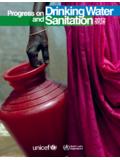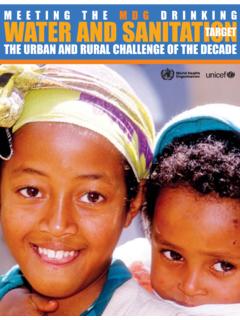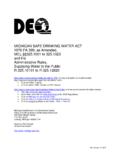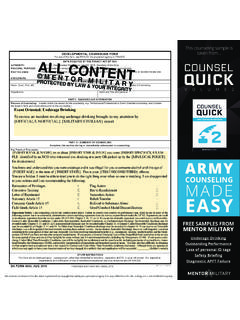Transcription of Sri Lanka Country Highlghts for Web - WHO
1 Sri LankaSanitation coverage in Sri Lanka is 92% the best in South Asia. Areas to improve would be rural school sanitation, sanitation facilities for the disabled and the problem of ground water contamination resulting from on-site sanitation in congested townships. drinking -water coverage is 94%. The remaining 6% of the population consume water by purchasing it from vendors who transport water in very unsanitary plastic containers, by walking more than two km, or from rivers, streams or unprotected wells. Efforts are being made to identify these communities to provide them with improved water supply is practiced in urban and semi urban environments. Rural communities are being educated on proper hygienic practices whenever possible using the services of public health inspectors, public health midwives, medical officers of health and the like. Whenever a water supply project is initiated in rural areas, a health education component is included for this purpose.
2 The school curriculum contains health education and environmental this manner, Sri Lanka is forging ahead to provide its people with good sanitation, safe drinking -water and health education to live a healthy the period 2013/2014, Sri Lanka experienced climate related disasters extreme drought and floods. More recently, unprecedented earth slips were experienced. These all dramatically affected critical WASH services. However, the Sri Lankan government s administration system was strong enough to take control of the situation and appropriate relief activities were was repeatedly supplied using water tankers to top up the available storage tanks and plastic cans. Temporary shelters were provided where appropriate at schools, temples and community centres where basic sanitation facilities were of this, the outbreak of an epidemic of water related disease was completely avoided.
3 The prompt relief action taken by government agents, disaster management centres and the villagers themselves created a situation where the affected community was provided with basic requirements very quickly. Relief efforts organised from other parts of the Country trickled in thereafter to augment the initial efforts. * Sanitation, drinking -water and hygiene status overview provided and interpreted by national focal point based on GLAAS , drinking -water and hygiene status overview*SANITATION AND drinking -WATER ESTIMATESUse of improved sanitation facilities (2012)f92%Use of drinking -water from improved sources (2012)f 94%f Progress on drinking -Water and Sanitation 2014 Update, WHO/UNICEF AND ECONOMIC ESTIMATESP opulation (2012) MUrban population (2012) MRural population (2012) MPopulation growth rate (2012) domestic product USD (2012)b billiona World Population Prospects: The 2012 Revision, UNDESA World Development Indicators, World Bank ESTIMATESI nfant mortality / 1,000 live births (2012)c 5 mortality / 1,000 live births (2012)c expectancy at birth (2012)d75 yrsDiarrhoea deaths attributable to WASH (2012)e 705c Levels & Trends in Child Mortality.
4 Report 2013, UNICEF World Health Statistics, WHO Preventing diarrhoea through better water, sanitation and hygiene, WHO World Health Organization 2015 All rights reserved. Publications of the World Health Organization are available on the WHO website ( ) or can be purchased from WHO Press, World Health Organization, 20 Avenue Appia, 1211 Geneva 27, Switzerland (tel.: +41 22 791 3264; fax: +41 22 791 4857;e-mail: Requests for permission to reproduce or translate WHO publications whether for sale or for non-commercial distribution should be addressed to WHO Press through the WHO website ( ).The designations employed and the presentation of the material in this publication do not imply the expression of any opinion whatsoever on the part of the World Health Organization concerning the legal status of any Country , territory, city or area or of its authorities, or concerning the delimitation of its frontiers or boundaries.)
5 Dotted and dashed lines on maps represent approximate border lines for which there may not yet be full reasonable precautions have been taken by the World Health Organization to verify the information contained in this publication. However, the published material is being distributed without warranty of any kind, either expressed or implied. The responsibility for the interpretation and use of the material lies with the reader. In no event shall the World Health Organization be liable for damages arising from its use. Design and layout by L IV Com S rl, Villars-sous-Yens, visual identifier design by Ledgard Jepson Ltd, Barnsley, South Yorkshire, by the WHO Document Production Services, Geneva, HIGHLIGHTS SRI Lanka GLAAS 2014 Highlights based on Country reported GLAAS 2013/2014 data1 PLAN AND TARGETS FOR IMPROVED SERVICESINCLUDED IN PLANCOVERAGE TARGET(%)YEARU rban sanitation 1002020 Rural sanitation 1002020 Sanitation in schools 1002020 Sanitation in health facilities 2017 Urban drinking -water supply 852015 Rural drinking -water supply 852015 drinking -water in schools 1002020 drinking -water in health facilities 2017 Hygiene promotion 2016 Hygiene promotion in schools 602020 Hygiene promotion in health facilities 2016I.
6 GovernanceThe National Water Supply and Drainage Board has the main responsibility for drinking -water. The Ministry of Health leads hygiene promotion initiatives and has a number of responsibilities in sanitation and INSTITUTIONS SANITATIONDRINKING-WATERHYGIENE PROMOTIONN ational Water Supply & Drainage Board Ministry of Health 1 All data represented in this Country highlight document is based on Country responses to GLAAS 2013/2014 questionnaire unless otherwise of ministries and national institutions with responsibilities in WASH: 6 Coordination between WASH actors includes: All ministries and government agencies Nongovernmental agencies Evidence supported decisions based on national plan and documentation of processSPECIFIC PLANS FOR IMPROVING AND SUSTAINING SERVICESaEXISTENCE AND LEVEL OF IMPLEMENTATION OF MEASURESLow HighKeep rural water supply functioning over long-termImprove reliability/continuity of urban water supplyTo rehabilitate broken public latrinesSafely empty or replace latrines when fullReuse of wastewater or septageEnsure DWQ meets national standardsAddress resilience to climate changea Including are several specific plans implemented addressing the issues of improving and sustaining services including micro-biological and chemical surveillance of MonitoringThere is a high level of data availability reported for decision-making.
7 Especially for drinking -water and the health national assessment December 2011 December 2011 December 2011 Use of performance indicatorsa Data availability for decision-makingaHealth sectorPolicy and strategy making Resource allocation NANational standardsNA NAResponse to WASH related disease outbreakNANA SurveillancebUrbanRuralUrbanRuralIndepen dent testing WQ against national standards NANA Independent auditing management procedures with verification NANA Internal monitoring of formal service providers CommunicationaPerformance reviews made public Customer satisfaction reviews made public a Few. Some. Not reported. Not used. Used and informs corrective : Not Human resourcesHuman resource strategies are developed for sanitation and drinking -water though gaps and follow up actions still need to be identified. The most important constraints identified are the lack of skilled graduates and that skilled workers do not want to live and work in rural RESOURCESSANITATIONDRINKING-WATERHYGIENE H uman resource strategy developeda Strategy defines gaps and actions needed to improvea Human resource constraints for WASHbAvailability of financial resources for staff costs Availability of education/training organisations Skilled graduates Preference by skilled graduates to work in other sectors Emigration of skilled workers abroad Skilled workers do not want to live and work in rural areas Recruitment practices Othera No.
8 In development. Ye Severe constraint. Moderate constraint. Low or no IN ACCESS1 Figure 4. Population with access to improved drinking -water sourcesFigure 3. Population with access to improved sanitation facilitiesFigure 2. Disaggregated WASH expenditureEQUITY IN FINANCEF igure 1. Urban vs. rural WASH fundingIV. FinancingA financing plan is in place and used for most WASH areas. Both domestic and donor commitements are able to be absorbed, however, there is an insufficiency of funds to meet MDG targets. FINANCINGSANITATIONDRINKING-WATERF inancing plan for WASHU rbanRuralUrbanRuralAssessment of financing sources and strategiesa Use of available funding (absorption)Estimated % of domestic commitments usedb Estimated % of donor commitments usedb Sufficiency of financeWASH finance sufficient to meet MDG targetsb a No agreed financing plan. Plan in development or only used for some decisions.
9 Plan/budget is agreed and consistently followed. b Less than 50%. 50 75%. Over 75%. V. EquityAs a step towards addressing equality in access to WASH services, nine disadvantaged groups are identified in WASH plans. Funds are largely directed to sanitation, which is where the need is currently greatest. EQUITY IN GOVERNANCESANITATIONDRINKING-WATERLawsRe cognize human right in legislation Participation and reportingaUrbanRuralUrbanRuralClearly defined procedures for participation Extent to which users participate in planning Effective complaint mechanisms a Low/few. Moderate/some. GROUPS IN WASH PLAN1. Poor populations2. People living in slums or informal settlements3. Remote populations4. Indigenous populations5. Displaced populations6. Ethnic minorities7. People living with disabilities8. People affected by disasters9. Elders and single parents1 Progress on drinking -Water and Sanitation 2014 Update, WHO/UNICEF VS.
10 OTHER EXPENDITURE DATAT otal WASH as a % [ No data available. ]1 Reported WASH expenditure in GLAAS 2013/2014 converted using UN exchange rate 31/12 Expenditure as a % GDP Average 2010 2012, sources UNESCO 2014, WHO WASH expenditure from Country GLAAS 2013 response, GDP Average 2010 2012, World Development Indicators, World Bank : Not HIGHLIGHTS SRI Lanka GLAAS 2014 Improved drinking -water accessUnserved94%rural6%Improved sanitation accessUnserved92%8%35urbanruralDrinking- waterSanitation32%68%

















